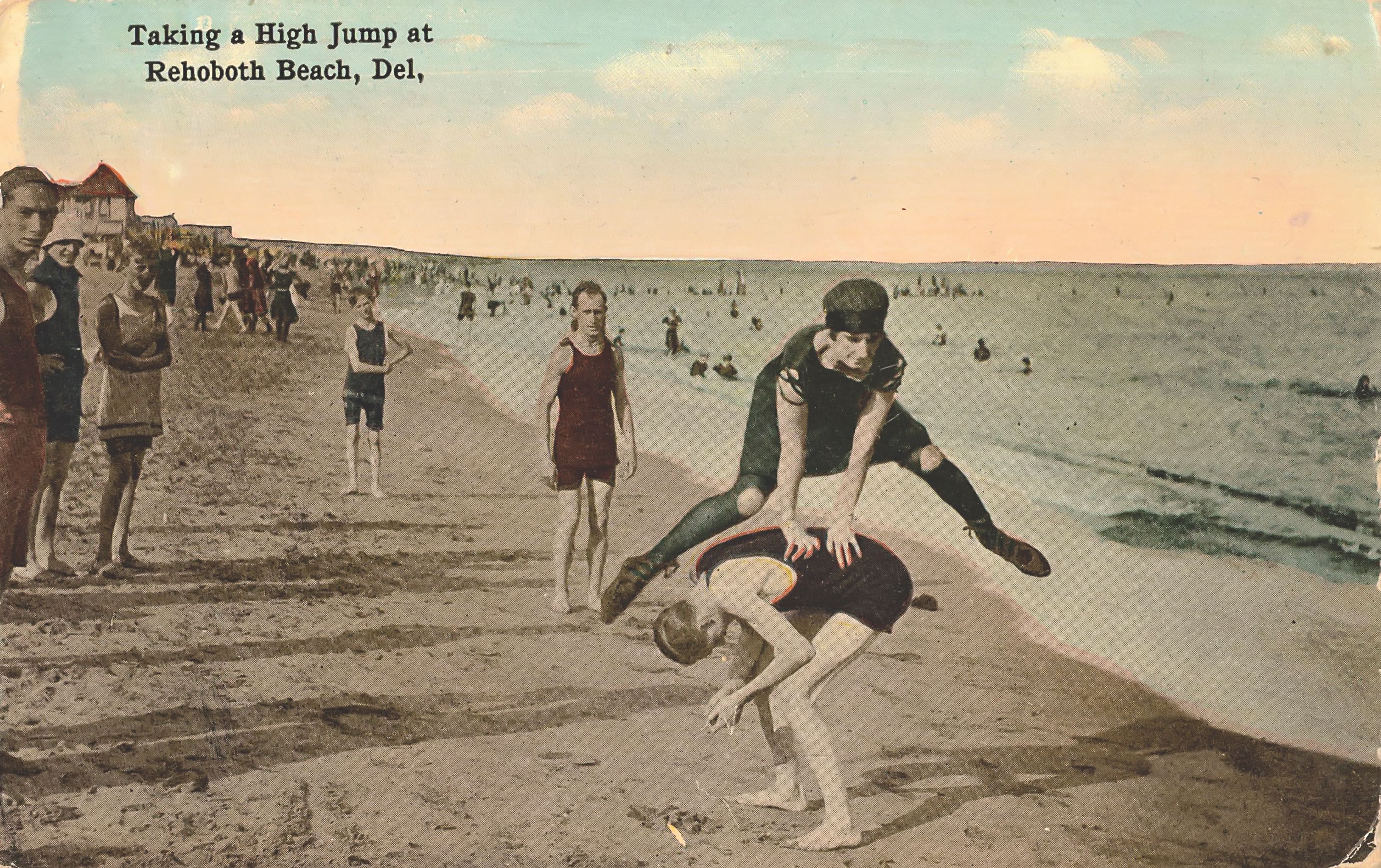
When creating a book from the Rehoboth Beach Museum’s postcard collection, these two designers didn’t just mail it in
By Bill Newcott
Photograph courtesy of the Rehoboth Beach Historical Society
From the July 2023 issue

The young woman in the photograph has clearly gotten a good running start, even on the soft sand of Rehoboth Beach. At this split second she is aloft, her legs spread at a wide angle, displaying a daring flash of knee that peeks into the summer sun from just below the skirt of her black woolen bathing suit and just above the long black stockings that reach up from her somewhat clunky-looking black shoes.
In a plucky show of feminine assertiveness, she is leapfrogging over a young man, his hair slicked down, his body positioned in a deep crouch. Beyond this frozen tableau, a few dozen bathers pause their vacation reveries to watch the action. Somewhere in that crowd, no doubt, a Civil War veteran, or perhaps his widow, is shaking their head and muttering, “Honestly. Young people today …”
The year is 1912, and this fleeting scene would have passed into the infinity of lost moments if not for the reflexes of an enterprising photographer — and the preservation of the image on a medium that revolutionized communication around the turn of the 20th century: a postcard.
“Telephones were not common then,” says David McDonald flipping through the exhaustive collection of vintage postcards at the Rehoboth Beach Museum. “Instead of calling someone, people would simply use postcards to send messages to one another in town, or even up to Milton or Milford.
“To them, postcards were like email or text messaging.”
McDonald is not being flippant with that comparison: In the museum’s 1,500-card collection are numerous postcards that were postmarked in the morning and delivered a few blocks away that afternoon.
“In fact,” he says, “because we had the railroad in town, we have one example of a card that was postmarked in Rehoboth Beach in the morning and it arrived in Camden, N.J., that afternoon.”
But the purely utilitarian aspect of postcards was not to last. Just as text messaging led to Facebook, plain-Jane postcards soon morphed into photo cards, which became a flashy way to share the sights and experiences of vacation with folks back home.
And because Rehoboth Beach was already a thriving vacation resort in the early 1900s, postcards of the town’s buildings, beach and boardwalk were soon finding their way into mailboxes across the country.
More than 400 of those postcards — and the ways they reflect the shifting social norms of the past 130 years — are lovingly presented in a new book by McDonald and fellow postcard enthusiast Roland Forster. “Greetings From Rehoboth Beach: Postcards From the Collection of the Rehoboth Beach Museum,” begins with a gallery of examples from what the two authors call postcards’ “Golden Age,” 1905-1915. In the heady days prior to World War I, fancifully illustrated postcards flew in every direction across coastal Delaware, as swift and plentiful as snow geese.
On one spread, a gallery of 1906-7 cards commemorates the consecration of St. Francis by the Sea, which once stood on the oceanfront between Laurel Street and Brooklyn Avenue. A moody interior shot shows a glowing stained-glass window above the altar along with a staple of Catholic churches then and now: life-size statues of Jesus, Mary, Joseph, and, in this case, the church’s patron saint, Francis of Assisi.
“It is too bad,” says a rather scolding handwritten inscription on another photo of the church, “that you have forgotten … the Lord.”
Like this one, many early cards have messages scrawled right across their images, because in those days the blank back side of a postcard was by law reserved solely for the mailing address. Postcard photographers learned early on to leave large, text-friendly areas in their shots. When the post office loosened that regulation, entire sagas, penned in the exquisitely formed handwriting of the era, took hold on the cards’ flip side.
From a 21st-century perspective, it’s easy to believe the wide expanse of Rehoboth Avenue was always punctuated at its ocean end with an old-timey gazebo, like the one that stands there today. But until 1914, the view was dominated by Horn’s Pavilion, a shop/theater/photo studio pier that stood dead center over the sand, its banners flying in the ocean breeze on the water side of the boardwalk.
There are surprisingly few postcard views of Horn’s Pavilion in the museum’s collection, probably because photographers were more interested in using the building’s second-story balcony as a vantage point for shooting down Rehoboth Avenue. Those westward-looking images show a view radically different from today’s: In hand-colored photos, the center of Rehoboth Avenue is a vast green lawn, with the street curving around it like a race track.
As pictured on a 1910 card, the ocean end of Rehoboth Avenue is still a promenade for grandly dressed pedestrians. Just four years later, another card shows the area clogged with cars. The caption: “The Automobile Crowd.”
In an age before wire service photographs could quickly bring the world to newspaper readers nationwide, postcards served as a way to send images of current local events to distant places. Photos of storm damage are a popular — and all-too frequent — subject of historic Rehoboth Beach cards. And then there’s the intriguing series of cards that show a large sailing ship sitting smack-dab on the beach at Rehoboth. It’s a schooner barge, called the Merrimac, that ran aground during a 1918 storm.
One photo, clearly taken from an airplane, shows the bow of the ship within feet of the boardwalk.
“They couldn’t get it off the beach,” says Forster. “Finally, it was just salvaged down to the sand. I’m sure whatever’s left is now way down under the sand.” (In a weird coincidence, another ship, the Thomas Tracy, wrecked on that very same spot off Brooklyn Avenue in 1944. The city erected pilings to warn beachgoers of the embedded debris, but most of those pilings, along with the remains of both ships, are now buried under sand from beach replenish-ment projects.)
No matter what their age, the postcards Forster and McDonald have curated into “Greetings From Rehoboth Beach” bristle with immediacy. The Cape Henlopen Lighthouse, pictured shortly before its cataclysmic 1926 collapse, teeters at the edge of its rapidly retreating sand dune. A steam locomotive, black smoke billowing into the salt air, pulls into town, laden with 1,000 or so day-trippers from Philadelphia or Baltimore. The Blue Hen Theatre on Rehoboth Avenue — built largely from the wreckage of Horn’s Pavilion, destroyed in a 1914 storm — is festooned with signage advertising Ronald Colman’s 1926 epic “Beau Geste.” Kids amble across a sandy miniature golf course in 1932, on a lot next door to the old Epworth Methodist Church. Pleasure boats cruise the new Lewes-and-Rehoboth Canal in 1916. And toward the book’s end, the new Henlopen Hotel, gleaming white, towers over a clutch of 1975 bathers.
“Let me show you something,” says Forster, flipping to a picture of Horn’s Pavilion from the beach side. He points to a small extension on the building’s northern end.
“Look here. See that? There’s a sign there that says ‘Postcards.’ It’s where you would buy your postcards of your visit to Rehoboth Beach.”
He gestures to the pages of the book, and to a bound volume of other vintage postcards on the table before us. “I would say a good many of these postcards were purchased right there!”
Forster leans back with a satisfied, almost beatific, smile. He glances over at McDonald, who nods and smiles back.
“Greetings From Rehoboth Beach,” it turns out, has been a labor of love in more ways than one. Forster and McDonald, both from Baltimore, had known each other casually for years, primarily through their shared enthusiasm for vintage postcards: Forster sold them at collectible shows, and McDonald, who had a special interest in old ocean liner cards, was a frequent customer.
The two became a couple in 2013 and moved to Rehoboth Beach full time in 2017. That’s when they became involved with the Rehoboth Beach Museum, helping renovate the facility’s second floor. They were married, in 2019, in the upstairs lecture hall — which happens to be decorated with enormous blow-ups of some prized vintage local postcards.
The popularity of a bound volume of cards in the museum’s gallery — along with a rotating PowerPoint display of vintage cards — inspired Forster and McDonald, with the blessing of museum Director Nancy Alexander, to start the book project. But the work involved more than just slapping a bunch of old pictures between a couple of covers.
Many of the cards were donated to the library by former Lewes Justice of the Peace Jim Horn — whose family published hundreds of cards and sold them at the long-gone Horn’s Pavilion. Others came from more far-flung sources, requiring hours of research to determine who published them and when.
Flip to the final pages of “Greetings From Rehoboth Beach” and you’ll find page upon page of references to postcard publishers — local and as far away as Seattle. And there is an individual entry for every one of the 400-plus images in the book, each paragraph the fruit of exhaustive investigation.
There are, of course, many other old Rehoboth Beach area postcards out there, gathering dust in attics or getting moldy in basements. Forster and McDonald hope the book — published by the museum, which will receive all the proceeds from sales — will inspire people to donate them to the growing collection.
“Years from now, maybe they’ll be able to expand on what we’ve done,” says Forster. “After all, they’re still printing postcards.”



